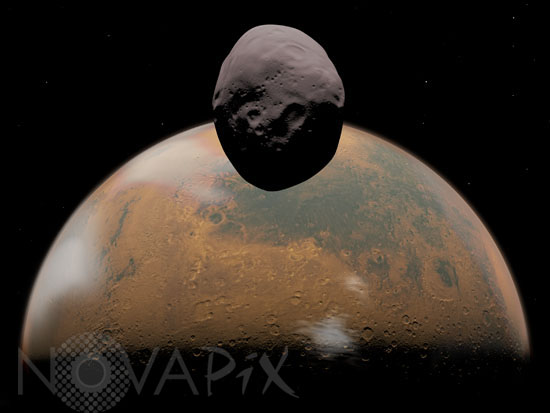Photo Agency - Astronomy - Space - Nature

Phobos and Mars - Illustration
author: Walter B. Myers/Novapix
reference: a-mar99-00013
Image Size 300 DPI: 33 * 25 cm
This is how Mars and its tiny satellite Phobos might appear from a distance of about 100 miles from Phobos' surface. Phobos is over the low martian plains of Syrtis Major. Below the plains extending down to Mars' terminator and beyond is the heavily cratered Terra Sabaea. Clouds of water-ice crystals are forming at the terminator between light and dark.
Looking more like a common potato than a celestial body, Phobos is actually the larger of Mars' two satellites, with a length of about 16 miles and about 11 miles across its smallest dimension. Phobos does not have enough mass for gravity to pull it into a uniform sphere like the larger satellites and planets in the Solar System.
Phobos may be an asteroid long ago captured by Mars' gravity, orbiting a mere 5,800 miles above Mars' surface, making it the closest satellite to its host planet in the Solar System. Phobos' orbit is so low that it completes one revolution in less than eight hours, easily outpacing by threefold Mars' rotation period of 24 hours, 40 minutes. The resulting tidal forces are causing Phobos' altitude to decay at the relatively rapid rate of 6 feet per century; in about 50 million years Phobos will either crash into the martian surface, or be torn apart by Mars' gravity.
Keywords for this photo:
ASTRONOMY - ILLUSTRATION - MARS - MARS MOON - PHOBOS - PLANET - SATELLITE -
Contact : Stéphane Aubin +33-(0)9-51-26-53-76
© Novapix - All rights reserved


